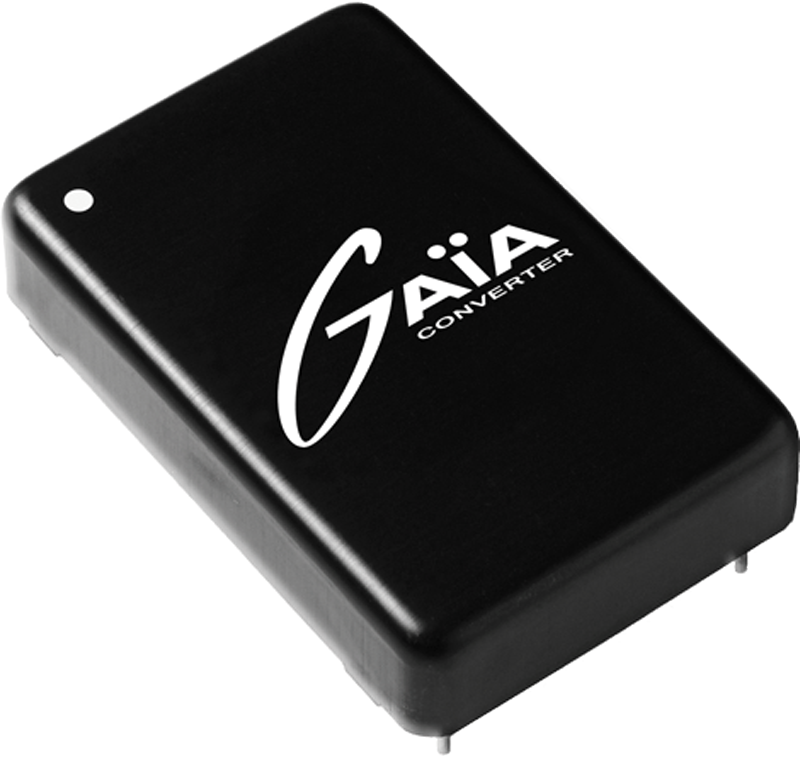
General Characteristics
- Additional functions : monitoring signals, programmable charging current limitation, programmable power fail threshold
- Charger switching frequency : 200
- Galvanic isolation input/output : non isolated
- Power range : from 4 W to 50 W
- Protections : reverse polarity
- Leaded on option
Key Features
- Compatible with 9-36 or 16-40 Vdc converters
- Dedicated to DO-160, MIL-704
- Reduce capacitance value by 80%
- Unique product for hold-up solutions
Series Description
The HUGD-50 features 3 modes of operations:
- Charging operation mode : when the input voltage ramps-up and reaches the start-up charge threshold (which is set at 1 Vdc above the "power fail voltage"), the HUGD-50 begins to charge the external capacitor at 38 Vdc while powering the dc/dc converter. The charging current is controlled and externally adjustable between 100 mA and 2 A by a resistor. The capacitor charging time depends on the charging current. When the capacitor voltage reaches 35 V, the signal (active low, open-drain) "capacitor charged" is activated and the HUGD-50 enters in the normal operation mode.
- Normal operation mode : in normal operation mode when the capacitor is charged and the input bus is between the "output power fail" and 40 Vdc, the HUGD-50 only consumes power to keep the capacitor charged (i.e.less than 1 W). The voltage drop between input and output is lower than 150 mV in the worst case (50W power and 9 Vdc input voltage) The HUGD-50 will operate indefinitely in this state until the input voltage drops below the "power fail voltage" threshold.
- Power fail mode : when the input voltage drops below the "power fail voltage" threshold, a "power fail" signal is activated and the HUGD-50 disconnects input from output and connects the hold-up capacitor to the output. At this point the DC/DC converters are powered by the capacitor. When its voltage finally discharges to a value slightly above the "power fail voltage" threshold value, a "capacitor discharged" flag is activated.
Product Selection
This product selection table includes all available versions. Other references may be offered – see technical datasheets.
For more information, please consult factory.
| Reference | Status | Output power | Input voltage | Max. transient input voltage | Output current | Case dimensions | Standard electrical functions | Adj. hold-up capa final voltage | Hold up mode threshold voltage | Operating case temp. range | Case material | Charger switching frequency | DC resistance | UVLO min | Voltage drop @ I max | Weight | Options | RoHS / SnPb |
|---|---|---|---|---|---|---|---|---|---|---|---|---|---|---|---|---|---|---|
| HUGD-50 | Active | 50 W | 9 - 40 Vdc | 50.0 Vdc / 100 ms | 5.6 A | 40.2 x 26.2 x 8.2 mm | CC, CD, PF, REV.POL | 38 Vdc non adj | 9.5 to 15.3 Vdc | -40 to 105 °C | Metallic black anodized coating | 200 KHz | 20 Grams | S |  | |||
| No data |
Output Nbr: S: Single output, B: Bi-outputs, D: Dual outputs, T: Triple outputs – Dual outputs products can be usable for single output or bi-outputs. Output Nbr E corresponds to a slave module (see DataSheet)
Case dimensions: L x W x H (maximum values in mm)
Standard electrical functions: Case: Case connection, OVLO: Input overvoltage lockout, UVLO: Input under voltage lockout, OCP: Output over current protection level, OPP: Output over power protection, OVP: Output over voltage protection level, SCP: Output short circuit protection, OTP: Over temperature protection, VIF: Pin for Input Current Ripple Reduction, SYNC: Pin for Synchronisation, TRIM: Pin for adjust ouput voltage, ITRIM: Pin for adjustement ouput current limitation, CC: Pin for capacitor charged signal, CD: Pin for capacitor discharged signal, UVLOadj: Pin for level undervoltage lockout adjust, VREF: Pin for output internal voltage reference, PF: Pin for power fail signal, SENSE: Pin for voltage regulation, REV.POL: Reverse polarity protection, SHARE: Pin for output current parallel sharing
Status NPR: Not preferred for new Design
Options: T Screening at start-up -55° C, Y High isolation 3000 Vdc, M On/Off function, S Screening and serialization, F Synchronization function, P Share function
Technical Documentation
Pin Out






